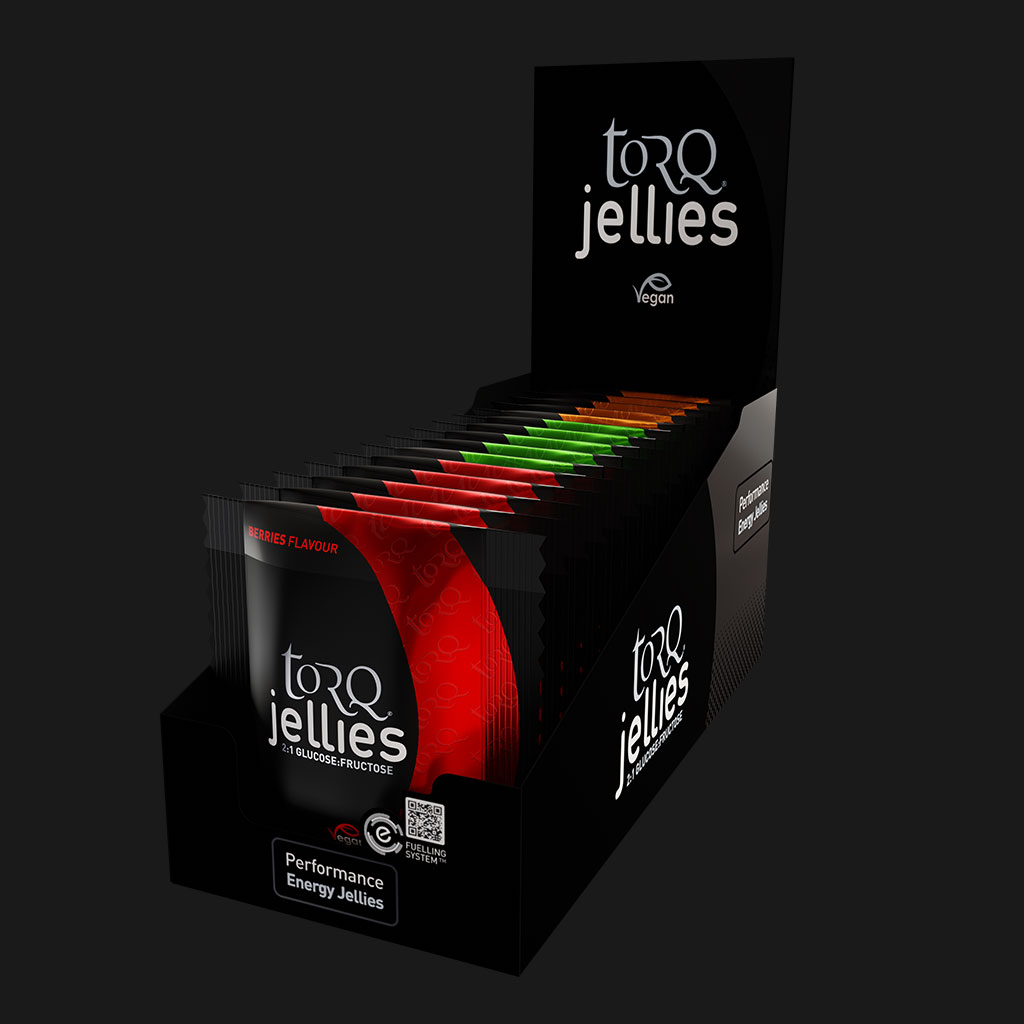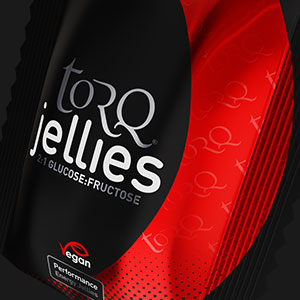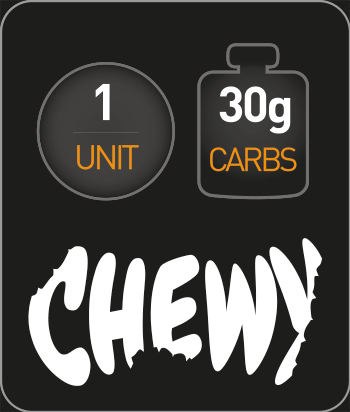Energy Jellies: Build-a-Box of 15 Jellies
£41.25
Energy Jellies: Build-a-Box of 15 jellies
You can build a box (or boxes) of your favourite flavours of TORQ Jellies from this page. Simply click/tap on the flavour of Jellies you would like to add to your box and watch the discounts kick in as you build more boxes.
Order Info:
0
£0.00
£0.00
Add 15 more items and save 10%.
The more you buy, the less you pay! You must add EXACTLY 15, 30 or 45 items to your boxes for the Buy Now button to function.
Product Highlights
- 2:1 Glucose:Fructose
- Multiple Transportable Carbohydrates
- Soft Energy Chews
- Igloo-Shaped/Easy to Dispense
- Temperature Stable
- Part of the TORQ Fuelling System
Product Summary
Our TORQ Jellies energy chew product has been carefully formulated to deliver TORQ’s unique blend of multiple-transportable carbohydrates to the working muscles extremely quickly and efficiently using research-proven 2:1 Glucose:Fructose technology.
TORQ Jellies form part of the TORQ Fuelling System, so can be used alongside TORQ’s energy drinks, gels and bars to fuel optimal performances. Please take the time to read about the TORQ Fuelling System by clicking HERE and ensure that you get the most out of this product.
Each pack of TORQ Jellies provides 30 grams of multiple-transportable carbohydrates (1 TORQ Unit). For optimal performances, our TORQ Fuelling System recommends consuming 2-3 TORQ Units per hour which can be achieved through consuming a variety of fuelling products as illustrated in the table below. Consuming a pack of 6 TORQ Jellies is simply one method of ingesting a TORQ Unit.

The higher your perspiration rates, the more TORQ Energy Drink you will need to consume relative to our more concentrated fuelling units – TORQ Jellies, TORQ Gels and TORQ Bars. All of our fuelling products are optimised with multiple-transportable carbohydrates, the only difference between them is the texture; Chewy, Smooth or Soft. The interaction between TORQ’s fuelling products is explained fully HERE on our Fuelling System page and the illustration below summarises the concept nicely.

Product Usage
TORQ Jellies are available in packs of 6 Energy Chews and in boxes of 15 (15 X 36g packs). Sample Packs are also available from which you can purchase TORQ Jellies packs individually to try, or combine with any number of other TORQ products. Postage is FREE, however small your order.
Each pack of TORQ Jellies contains 30g of multiple-transportable carbohydrates and represents 1 TORQ Unit. Each individual energy chew contains 5g of multiple-transportable carbohydrates.
The TORQ Fuelling System page of this website clearly explains how TORQ Jellies work alongside TORQ’s other fuelling products (TORQ Energy Drink, TORQ Bar and TORQ Gel). TORQ Jellies represent the most convenient method of grazing on 30 grams of carbohydrate (1 TORQ Unit) over time and their soft chewy texture and delicious flavours make them a very pleasant way to deliver the fuel you need during exercise. With all of TORQ’s fuelling products containing the same 30g dose of carbohydrate, the beauty of the TORQ Fuelling System is that it offers a wide choice of flavours and textures as we accept that everyone has different fuelling preferences.
Please take the time to watch this short video to learn how the TORQ’s fuelling products work together as part of the TORQ Fuelling System. Please note that this video is in the process of being updated, so please consider any reference to ‘Chews’ to mean TORQ Jellies:

Technical Information
Multiple-Transportable Carbohydrates: TORQ Jellies energy chews utilise a 2:1 blend of glucose-derivatives and fructose founded on a now substantial body of peer-reviewed published research (see References tab). This dual-delivery carbohydrate formulation has been proven beyond doubt to supply energy faster than any other combination of carbohydrates or single carbohydrate source formulations. Take a look at the two very short animations below, which demonstrate how 2:1 Glucose-Derivatives:Fructose deliver over 40% more carbohydrate to the blood per hour than single glucose sources (the next best option).


For a comprehensive background to the research into multiple-transportable carbohydrates, visit the TORQ Fuelling System page on this website and look at the tab entitled Why 2:1? Here we thoroughly explain the research and why we have incorporated it into this product and others in the fuelling range.
Hypertonicity: The concentrated nature of this product pitches our TORQ Jellies tonicity firmly into the hypertonic zone, meaning that the product has been optimised to prioritise fuel delivery over fluid supply. This, in combination with the unique integration of multiple-transportable carbohydrates and their chewy, easy to swallow texture, makes our TORQ Jellies an extremely potent concentrated fuel source. The TORQ Fuelling System outlines how TORQ Jellies should be used in combination with our other fuelling products, so please take the time to read this section of the website.
Hydration Management: TORQ Jellies energy chews will clearly not satisfy your hydration requirements, so it is vital that you use this product in conjunction with TORQ Energy Drink to ensure optimal physical performance. As the TORQ Fuelling System confirms, you may experience high perspiration situations where the intake of TORQ Jellies units should be limited in favour of TORQ Energy Drink consumption to address the body’s fluid and electrolyte requirements. On the other hand, in low perspiration environments, TORQ Jellies and our other concentrated TORQ Units such as TORQ Gel and TORQ Bar should represent a more significant proportion of your fuel intake. As long as 2-3 TORQ Units per hour is maintained in every scenario, fuelling will be optimal, you just need to drink more of your fuelling units if perspiration rates are high and less when lower. The infographics and video in the previous tabs clearly illustrate this concept.
TORQ do produce a hypotonic product, which prioritises fluid delivery over fuel supply and it’s called TORQ Hydration. This product has been designed for situations where perspiration rates are exceptionally high and fuel delivery is less important – for instance, sessions lasting less than 1 hour in a warm environment, like high intensity indoor training. With these kinds of workouts, TORQ Hydration Drink would be a more functional choice over TORQ Energy Drink and certainly over any of our more concentrated fuelling products like TORQ Jellies. Read more about TORQ Hydration Drink HERE. By the same token, with the advancement of indoor cycling technology like Zwift and Sufferfest, exercise sessions lasting over an hour in duration are now commonplace. Sessions lasting longer than an hour, whether indoors or outdoors require fuelling as well as hydration, so again the principles of the TORQ Fuelling System will apply.
Easy & Pleasant to Eat: It’s a simple concept, but a very important one. The flavour and texture of our TORQ Jellies energy chews have been painstakingly considered, so that fuelling with optimally with this product is also a pleasure. The closest resemblance to flavour and texture we could describe is that of traditional jelly before hot water is added to it – the chunks of concentrated jelly you used to be treated to as a kid. Our TORQ Jellies are however plant-based, don’t contain any colouring and are formulated with physical performance in mind. The domed igloo shape of each energy chew also makes them very easy to dispense from the packet.
Gluten Free & Vegan Formulation: TORQ Jellies are a gluten-free fuelling product. The formulation for TORQ Jellies is also entirely plant-based, so is suitable for Vegans.
Natural Flavours & No Colours: Under exercise stress, digestion is affected as blood is diverted to the working muscles and any solutes added to a product will raise its osmolality unnecessarily making it harder to digest, so irrespective of the health debate surrounding the consumption of artificial ingredients, during exercise is certainly not the time to take them. Therefore, we only use natural flavours that the body can recognise and break down easily and we don’t use colours (artificial or natural), because they simply don’t need to be in the product.
No Artificial Sweeteners: For the same reasons as highlighted above, we don’t believe in the use of artificial sweeteners like Aspatame, Acsulfame-K, Saccharine and Sucralose. These artificial sweeteners are 100’s of times sweeter than sugar and Aspartame/Acsulfame-K are particularly controversial with regard to long-term health. They offer no performance benefit at all and our stance is the same with these as with colours and preservatives – if they don’t need to be included in our formulations for functional reasons, why include them?
Immune Support
The research is clear, fuelling with carbohydrate and ensuring that you consume a Recovery Drink immediately after exercise will not only boost performance and assist in the overall recovery process, but it will also support your immune system, leaving you less vulnerable to infection.
According to research by Gleeson and Bishop (2000) carbohydrate becomes an important fuel for the immune system cells which can increase tenfold during and post exercise when compared with resting conditions. These immune system cells are boosted by the body to help immunity at this vulnerable time and Carbohydrate supports their effectiveness. Also, according to Cupps and Fauci (1982) cortisol, a stress hormone that is linked to immunosuppression, is inhibited by the presence of Carbohydrate.
Ed Burke (2002) dedicates 2 pages of his book ‘Serious Cycling’ to the role that fuelling with carbohydrate during exercise plays in strengthening the immune system. Talking of researcher Dr Nieman, he says:
“Our research shows that sports drinks not only provide carbohydrate energy during exercise, but support the link between sports drinks and less stress on the immune system. Carbohydrate drinks of about 6 to 10% carbohydrate (TORQ Energy Drink is within this range) will not eliminate the stress of cycling, but our research and work of others show they can reduce the increase of several by-products of stress and hard exercise.”
In cooler conditions, when drinking an energy drink is less desirable, as our Fuelling System suggests, carbohydrate can be delivered in more appropriate concentrated forms like our Energy Jellies, Energy Bars and Energy Gels.
All of this points to ensuring that you maintain good fuelling practices and that you feed immediately with Carbohydrate immediately after exercise. TORQ Recovery Drink provides this carbohydrate, along with a potent dose of Glutamine, which has also been found to assist and support the immune system following exercise.
If you are interested in learning more, we have created the definitive guide to help you understand what your immune system is, how it works, how to strengthen it and how to fight infection effectively should your immune defences be breached. Click HERE for further information. Also, as a direct result of producing these resources, we have since developed 2 specific Immune System Support products:
Our TORQ dFND product has been developed from a need to offer our customers a simple one-a-day tablet solution to deliver high-potency Vitamin D and Zinc to support the healthy daily functioning of the immune system. For further details or to purchase TORQ dFND, click HERE.
Our TORQ aTAC product provides research-recommended doses of Vitamin C, Glutamine and Echinacea through a mega-dosing protocol inspired by the studies we have referred to within these resources. TORQ aTAC is to be taken at the first signs of cold or flu to reduce the symptoms and severity of illness. For further details or to purchase TORQ aTAC, click HERE.
Nutritional Information
Nutritional Information for all flavours of TORQ Energy Jellies are supplied under this tab.
Orange Flavour
Ingredients: Multiple-Transportable Carbohydrates (Glucose Syrup, Sucrose, Fructose Syrup) (91%), Water, Gelling Agent: Pectin, Acid: Citric Acid, Natural Flavouring, Glazing Oil (Coconut Oil, Glazing Agent: Carnauba Wax).
| per 100g | per 36g serve | per 6g jelly | |
|---|---|---|---|
| Energy (kJ) | 1404 | 505 | 84 |
| Energy (kcal) | 331 | 119 | 20 |
| Fat (g) | 0.2 | 0.1 | <0.1 |
| of which saturates (g) | 0.2 | 0.1 | <0.1 |
| Carbohydrate (g) | 81 | 29 | 4.9 |
| of which sugars (g) | 69 | 25 | 4.1 |
| Fibre (g) | 2.7 | 1.0 | 0.2 |
| Protein (g) | 0 | 0 | 0 |
| Salt (g) | 0.13 | 0.05 | 0.01 |
Allergy Information: No allergens.
No Colours // No Artificial Sweeteners // Natural Flavouring // Wheat-Free // Dairy-Free // Suitable for Vegans
Lime Flavour
Ingredients: Multiple-Transportable Carbohydrates (Glucose Syrup, Sucrose, Fructose Syrup) (89%), Water, Gelling Agent: Pectin, Natural Flavouring, Acid: Citric Acid, Glazing Oil (Coconut Oil, Glazing Agent: Carnauba Wax).
| per 100g | per 36g serve | per 6g jelly | |
|---|---|---|---|
| Energy (kJ) | 1378 | 496 | 83 |
| Energy (kcal) | 325 | 117 | 20 |
| Fat (g) | 0.2 | 0.1 | <0.1 |
| of which saturates (g) | 0.2 | 0.1 | <0.1 |
| Carbohydrate (g) | 79 | 28 | 4.7 |
| of which sugars (g) | 67 | 24 | 4.0 |
| Fibre (g) | 2.7 | 1.0 | 0.2 |
| Protein (g) | 0 | 0 | 0 |
| Salt (g) | 0.13 | 0.05 | 0.01 |
Allergy Information: No allergens.
No Colours // No Artificial Sweeteners // Natural Flavouring // Wheat-Free // Dairy-Free // Suitable for Vegans
Berries Flavour
Ingredients: Multiple-Transportable Carbohydrates (Glucose Syrup, Sucrose, Fructose Syrup) (90%), Water, Gelling Agent: Pectin, Natural Flavouring, Acid: Citric Acid, Glazing Oil (Coconut Oil, Glazing Agent: Carnauba Wax).
| per 100g | per 36g serve | per 6g jelly | |
|---|---|---|---|
| Energy (kJ) | 1378 | 496 | 83 |
| Energy (kcal) | 326 | 117 | 20 |
| Fat (g) | 0.2 | 0.1 | <0.1 |
| of which saturates (g) | 0.2 | 0.1 | <0.1 |
| Carbohydrate (g) | 80 | 29 | 4.8 |
| of which sugars (g) | 68 | 24 | 4.1 |
| Fibre (g) | 2.7 | 1.0 | 0.2 |
| Protein (g) | 0 | 0 | 0 |
| Salt (g) | 0.13 | 0.05 | 0.01 |
Allergy Information: No allergens.
No Colours // No Artificial Sweeteners // Natural Flavouring // Wheat-Free // Dairy-Free // Suitable for Vegans
ISO17025 Testing Protocol: TORQ have a dedicated testing procedure in place under ISO17025 to provide assurance to our customers that our recipes are free from any contaminants/prohibited substances that could give rise to a positive drug/dope test. For further information, click HERE to view the TORQ Tested ISO17025 products that we have available for purchase and to learn more about our procedures.
TORQ Jellies are available in packs of 6 Energy Chews and in boxes of 15 (15 X 36g packs). Sample Packs are also available from which you can purchase TORQ Jellies packs individually to try, or combine with any number of other TORQ products. Postage is FREE, however small your order.
If you have any questions about this product or any other on this website, please don’t hesitate in contacting us at enquiries@torqfitness.co.uk or on 0344 332 0852.
Research References
- Stellingwerff, T & Cox, GR. (2014)
Systematic review: Carbohydrate supplementation on exercise performance or capacity of varying durations. Appl Physiol Nutr Metab. 2014 Sep;39(9):998-1011. - Wilson. PB., Ingraham, SJ. (2015)
Glucose-fructose likely improves gastrointestinal comfort and endurance running performance relative to glucose-only. Scand J Med Sci Sports. [Epub ahead of print]. - Currell, K & Jeukendrup, A.E. (2008)
Superior endurance performance with ingestion of multiple transportable carbohydrates. Med Sci Sports Exerc. 40(2):275–81. - Triplett, D., Doyle, D., Rupp, J., Benardot, D. (2010)
An isocaloric glucose-fructose beverage’s effect on simulated 100-km cycling performance compared with a glucose-only beverage. Int J Sport Nutr Exerc Metab. 20(2):122–31 - Tarpey, M.D., Roberts, J.D., Kass, L.S., Tarpey, R.J., Roberts, M.G. (2013)
The ingestion of protein with a maltodextrin and fructose beverage on substrate utilisation and exercise performance. Appl Physiol Nutr Metab. 38(12):1245–53. - Rowlands, D.S., Swift, M., Ros, M., Green, J.G. (2012)
Composite versus single transportable carbohydrate solution enhances race and laboratory cycling performance. Appl Physiol Nutr Metab. 37(3):425–36. - Baur, D.A., Schroer, A.B., Luden, N.D., Womack, C.J., Smyth, S.A., Saunders, M.J. (2014)
Glucose-fructose enhances performance versus isocaloric, but not moderate, glucose. Med Sci Sports Exerc. 46(9):1778–86. - Rowlands, D.S., Thorburn, M.S., Thorp, R.M., Broadbent, S.M., Shi, X. (2008)
Effect of graded fructose co-ingestion with maltodextrin on exogenous 14C-fructose and 13C-glucose oxidation efficiency and high-intensity cycling performance. J Appl Physiol. 104:1709–19. - O’Brien, W.J & Rowlands, D.S. (2011)
Fructose-maltodextrin ratio in a carbohydrate-electrolyte solution differentially affects exogenous carbohydrate oxidation rate, gut comfort, and performance. Am J Physiol Gastrointest Liver Physiol. 300(1):G181–9. - O’Brien, W.J., Stannard, S.R., Clarke, J.A., Rowlands, D.S. (2013)
Fructose–maltodextrin ratio governs exogenous and other CHO oxidation and performance. Med Sci Sports Exerc. 45(9):1814–24. - Rowlands, D.S., Swift, M., Ros, M., Green, J.G. (2012)
Composite versus single transportable carbohydrate solution enhances race and laboratory cycling performance. Applied Physiology, Nutrition, and Metabolism. 37(3): 425-436. - Smith, J.W., Pascoe, D.D., Passe, D., Ruby, B.C., Stewart, L.K., Baker, L.B., et al. (2013)
Curvilinear dose-response relationship of carbohydrate (0–120 g·h−1) and performance. Med Sci Sports Exerc. 45(2):336–41. - Roberts, J.D., Tarpey, M.D., Kass, L.S., Tarpey, R.J., Roberts, M.G. (2014)
Assessing a commercially available sports drink on exogenous carbohydrate oxidation, fluid delivery and sustained exercise performance. J Int Soc Sports Nutr. 11(1):1–14. - Jentjens, R.L., Underwood, K., Achten, J., Currell, K., Mann, C.H., Jeukendrup, A.E. (2006)
Exogenous carbohydrate oxidation rates are elevated after combined ingestion of glucose and fructose during exercise in the heat. J Appl Physiol. 100(3):807–16. - Jeukendrup, A.E & Moseley, L. (2010)
Multiple transportable carbohydrates enhance gastric emptying and fluid delivery. Scand J Med Sci Sports. 20(1):112–21. - Davis, J.M., Burgess, W.A., Slentz, C.A., Bartoli, W.P. (1990)
Fluid availability of sports drinks differing in carbohydrate type and concentration. Am J Clin Nutr. 51(6):1054–7. - Jentjens, R.L., Venables, M.C., Jeukendrup, A.E. (2004)
Oxidation of exogenous glucose, sucrose, and maltose during prolonged cycling exercise. J Appl Physiol. 96(4):1285–91. - Jentjens, R.L., Achten, J., Jeukendrup, A.E. (2004)
High oxidation rates from combined carbohydrates ingested during exercise. Med Sci Sports Exerc. 36(9):1551–8. - Wallis, G.A., Rowlands, D.S., Shaw, C., Jentjens, R.L., Jeukendrup, A.E. (2005)
Oxidation of combined ingestion of maltodextrins and fructose during exercise. Med Sci Sports Exerc. 37(3):426–32. - Jentjens, R.L., Moseley, L., Waring, R.H., Harding, L.K., Jeukendrup, A.E. (2004)
Oxidation of combined ingestion of glucose and fructose during exercise. J Appl Physiol. 96(4):1277–84. - Jentjens, R.L & Jeukendrup, A.E. (2005)
High rates of exogenous carbohydrate oxidation from a mixture of glucose and fructose ingested during prolonged cycling exercise. Brit J Nutr. 93:485–92. - Fuchs, C.J., Gonzalez, J.T., Beelen, M., Cermak, N.M., Smith, F.E., Thelwall, P.E., Taylor, R., Trenell, M.I., Stevenson, E.J., van Loon, L.J. (2016)
Sucrose ingestion after exhaustive exercise accelerates liver, but not muscle glycogen repletion compared with glucose ingestion in trained athletes. J Appl Physi. [Epub ahead of print].
For reviews see:
Jeukendrup, A.E., 2010. Carbohydrate and exercise performance: the role of multiple transportable carbohydrates. Curr Opin Clin Nutr Metab Care. Jul;13(4):452-7.
Rowlands, D.S., Houltham, S., Musa-Veloso, K., Brown, F., Paulionis, L., Bailey, D., 2015. Fructose-Glucose Composite Carbohydrates and Endurance Performance: Critical Review and Future Perspectives. Sports Med. Nov;45(11):1561-76.
For research linking immunity to carbohydrate ingestion during and post exercise:
Gleeson, M. and Bishop, N.C., 2000. Modification of immune responses to exercise by carbohydrate, glutamine and anti‐oxidant supplements. Immunology and Cell Biology, 78(5), pp.554-561.
Cupps, T.R. and Fauci, A.S., 1982. Corticosteroid‐mediated immunoregulation in man. Immunological reviews, 65(1), pp.133-155.
Burke, E.R., 2002. Serious Cycling. Human Kinetics. pp.154-155.
















